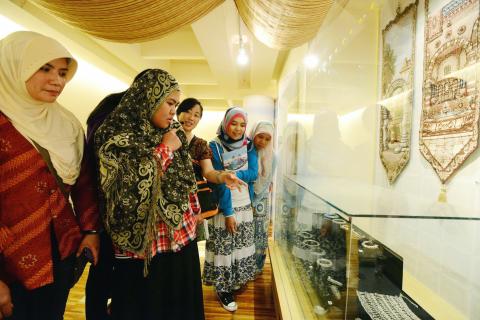Next Sunday, Taiwan’s oldest museum hopes to lure a more diverse crowd through its front door.
The National Taiwan Museum (NTM, 國立台灣博物館) is holding an “open museum day,” offering free admission for migrant workers and foreign spouses to all exhibits on Sunday, Sept. 14.
There’s the Exhibition of Islamic Life and Culture (伊斯蘭:文化與生活特展), which will be on view for its final day.

Photo Courtesy of National Taiwan Museum
By popular demand, Exhibition of Islamic Life and Culture has been extended from its original closing date of June 22 to next Sunday.
This special exhibition presents religious artifacts, manuscripts, musical instruments and other objects that survey Islamic civilization and daily life.
NTM, located at the 228 Peace Memorial Park in downtown Taipei, opened its doors in 1908. It is the only museum established during the Japanese colonial era that is still in operation at its original site.
On Sundays and holidays, the 228 Peace Memorial Park is full of migrant workers, new immigrants and foreign spouses meeting friends on their day off.
Workers seldom enter the museum for a visit, according to museum staff.
“I asked our staff to speak to them and to find out why. Most of them preferred to stay at a distance because they didn’t think the museum was for foreigners and blue-collar workers,” said NTM deputy director Lin Hwa-ching (林華慶).
Lin said NTM wants to connect with migrant workers and new immigrants, particularly to invite them into the Exhibition of Islamic Life and Culture.
“Quite a number of migrant workers and foreign spouses are from Indonesia and are Muslims. So this exhibit can promote multicultural dialogue and mutual exchange,” he said.
Lin said that the exhibit may also be able to help the children of international marriages explore the cultural traditions of their parent’s home country.
Next Sunday, visitors can also view NTM’s other exhibits: Mysterious Pescadores, about the biodiversity and marine geomorphology of southern Penghu County’s four islands; Taiwan Black Jade, about unique Taiwanese gems from the metamorphic rocks of the east coast; and an exhibition on the Hokutolite (北投石), a radium-containing rare mineral from Beitou’s hot springs which was discovered in 1905 by the renowned Japanese mineralogist Okamoto Yohachiro.

Exceptions to the rule are sometimes revealing. For a brief few years, there was an emerging ideological split between the Democratic Progressive Party (DPP) and Chinese Nationalist Party (KMT) that appeared to be pushing the DPP in a direction that would be considered more liberal, and the KMT more conservative. In the previous column, “The KMT-DPP’s bureaucrat-led developmental state” (Dec. 11, page 12), we examined how Taiwan’s democratic system developed, and how both the two main parties largely accepted a similar consensus on how Taiwan should be run domestically and did not split along the left-right lines more familiar in

As I finally slid into the warm embrace of the hot, clifftop pool, it was a serene moment of reflection. The sound of the river reflected off the cave walls, the white of our camping lights reflected off the dark, shimmering surface of the water, and I reflected on how fortunate I was to be here. After all, the beautiful walk through narrow canyons that had brought us here had been inaccessible for five years — and will be again soon. The day had started at the Huisun Forest Area (惠蓀林場), at the end of Nantou County Route 80, north and east

Specialty sandwiches loaded with the contents of an entire charcuterie board, overflowing with sauces, creams and all manner of creative add-ons, is perhaps one of the biggest global food trends of this year. From London to New York, lines form down the block for mortadella, burrata, pistachio and more stuffed between slices of fresh sourdough, rye or focaccia. To try the trend in Taipei, Munchies Mafia is for sure the spot — could this be the best sandwich in town? Carlos from Spain and Sergio from Mexico opened this spot just seven months ago. The two met working in the

This month the government ordered a one-year block of Xiaohongshu (小紅書) or Rednote, a Chinese social media platform with more than 3 million users in Taiwan. The government pointed to widespread fraud activity on the platform, along with cybersecurity failures. Officials said that they had reached out to the company and asked it to change. However, they received no response. The pro-China parties, the Chinese Nationalist Party (KMT) and Taiwan People’s Party (TPP), immediately swung into action, denouncing the ban as an attack on free speech. This “free speech” claim was then echoed by the People’s Republic of China (PRC),